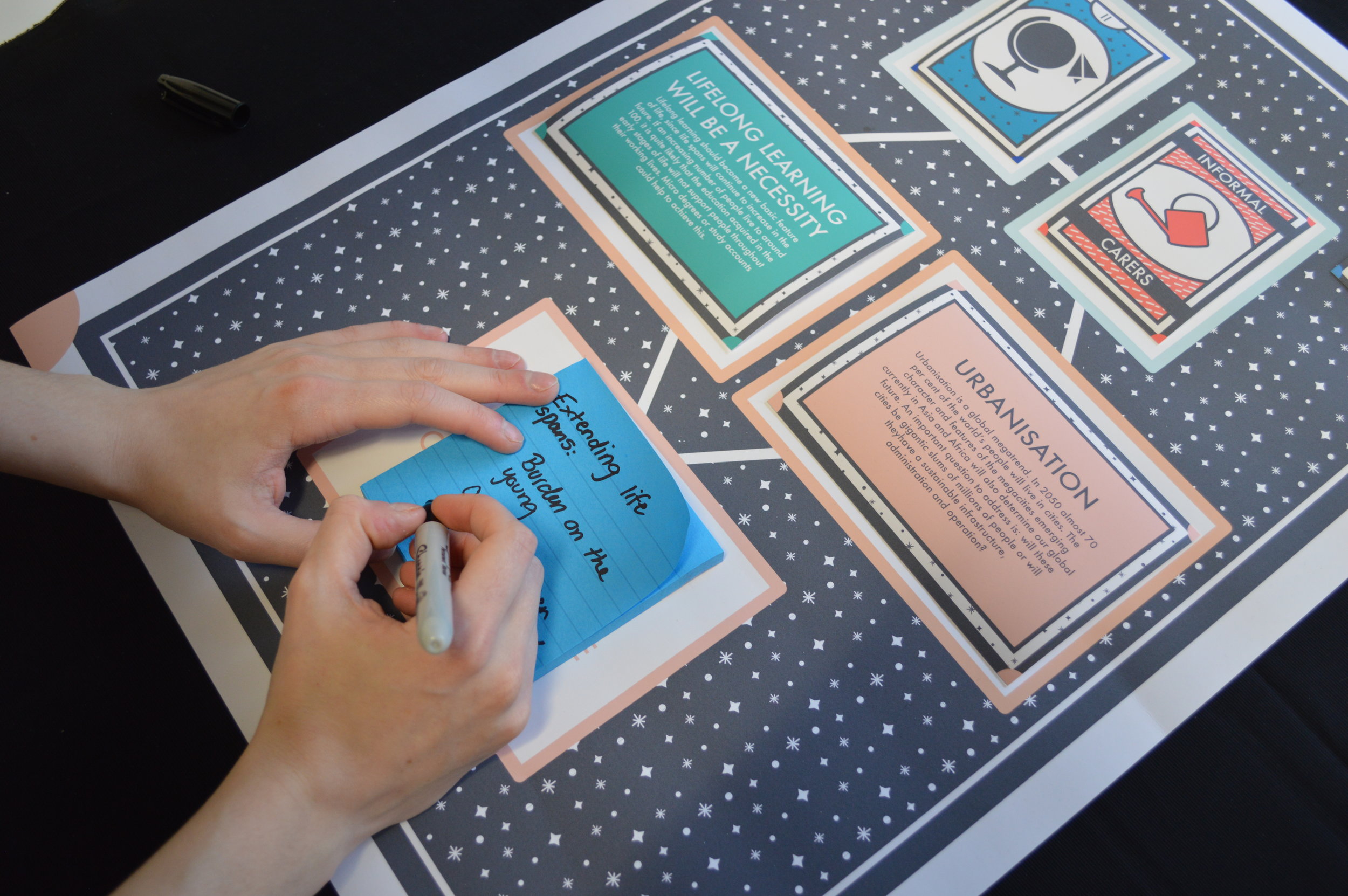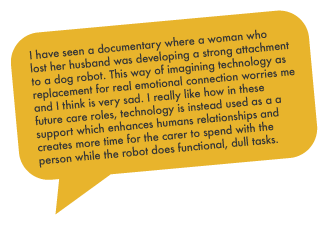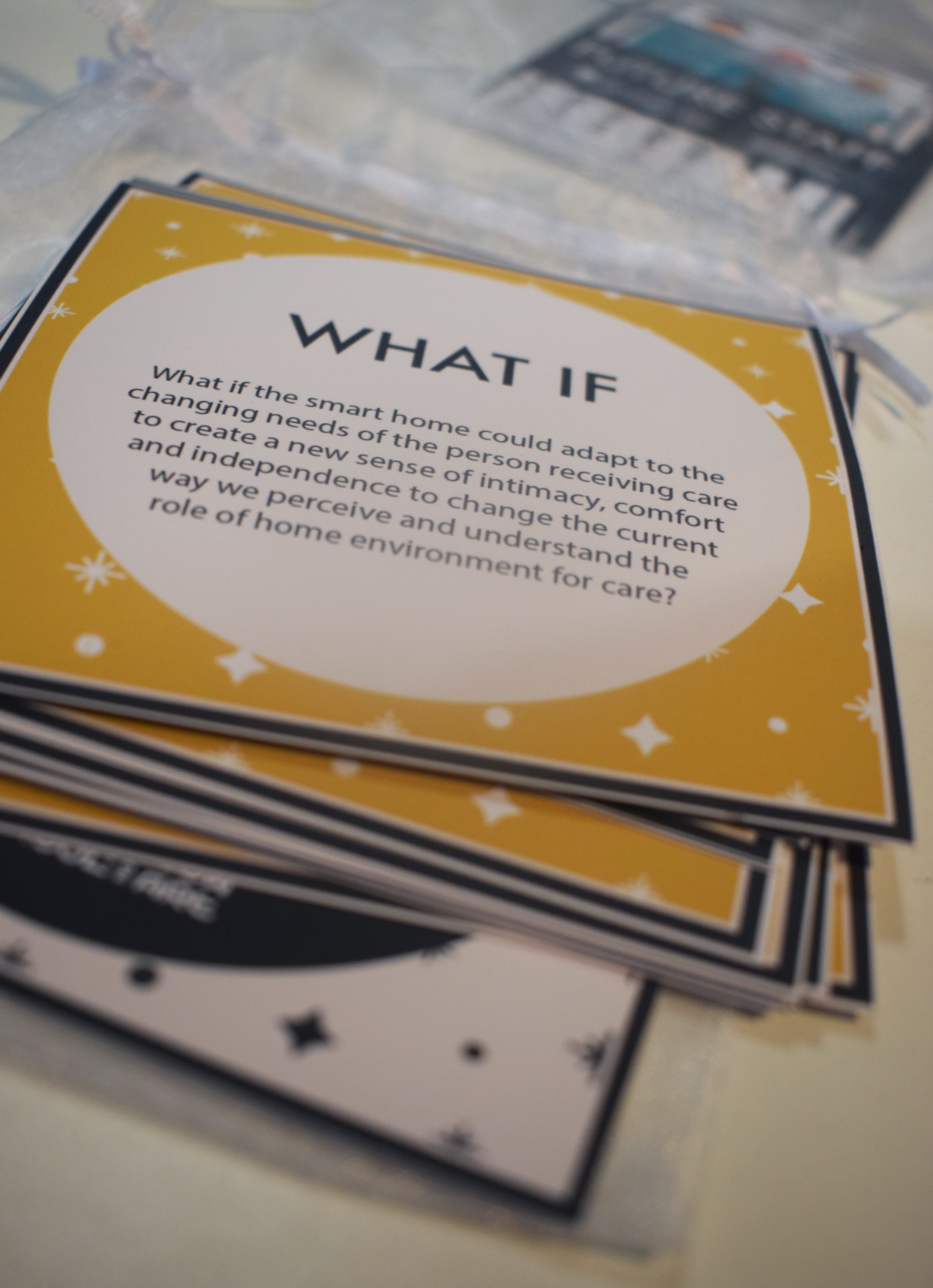A creative FUTURE for CARE AT HOME
BACKGROUND
'A creative future for care at home' involved a collaboration with Scottish Care to explore and co-create a series of possible scenarios for care at home in Scotland based on trends from the present. We supported care providers and frontline staff to creatively explore a future vision for care at home using a future-oriented design approach. Our design methods offered a way to integrate perspectives across the sector, transform challenges into areas of opportunity based on current trends and make tangible the way in which care at home could change in the future. Our approach and outcomes aim to build capacity in the sector and enable Scottish Care to continue this conversation by engaging a wider audience to collectively shape and progress a preferable vision for care at home in Scotland.
The challenges facing the care at home sector are well-known and increasing. There is a need for more funding, more recognition for care staff, and for a shift towards a preventative, relationship-based and personalised model of care that will support people to live independently for longer and lead to better outcomes for those being supported. Work to date has focussed on identifying the challenges and underlying principles that will enable this shift, however what is missing from these discussions is a creative and dynamic approach towards communicating and illustrating a vision for care at home in a more tangible way and to involve key stakeholders, care at home providers and frontline staff, in the process of re-imagining a better future.
Project Aim
To creatively explore and prototype a future of care at home that is underpinned by the National Health and Social Care Standards and engages a dynamically different sector.
Methodology
'Here and Now'
Our research process began with an exploration of the “Here and Now” of care at home in order to gain a contextual understanding of the current challenges, aspirations and areas of opportunity. The first phase involved a period of desk research building on existing work led by Scottish Care and reviewing wider literature on models of care and support at home. In addition, a member of the research team undertook observation and shadowing with care at home service in order to gain a more immersive understanding of the context. Finally, we employed a pop-up engagement (Teal and French, 2016) at the “Design, Technology and Dementia" conference at the University of Stirling to include the voice of academics and other practitioners involved in the wider research landscape of care.
The findings of the contextual research phase were presented back to Scottish Care as part of a “sense checking” workshop to share the understanding of the context and identify areas of priority to be addressed through the current project. The insights that emerged from this activity highlighted that both the current challenges and solutions for the immediate future of care at home are actually quite clear.
The outcomes from the sense checking workshop shaped the direction of the project to explore what the future of care at home will look and feel like in 25 years. Exploring this future included developing an understanding of what objects, technologies, and ideas will be important, and which actors will make up care at home in the future. In 25 years, ways of living will be different. People will have different views and life experiences, and will have grown up in different technological, economic and social climates, with different family structures, friendships, and relationships. People will hold different opinions on what it means to 'live well'. These differences are very important to consider when exploring the future of care at home.
'There and then'
To explore these questions and speculate about possible new roles for care at home and the wider landscape, we applied a future-oriented design approach, in which creative and visual methods were used during participatory design workshops with frontline carers and care providers. In both workshops, participants were invited to share their current experiences of providing care at home and were supported to imagine future scenarios of care at home using a series of design tools.
During workshop 1 (care organisers), participants worked in small groups using future trend cards to build a future scenario of care as a response to some of the current challenges shared. Using materials and playful objects, participants considered the people and organisations involved in the scenario, their role and impact on areas of opportunity. As a group, participants discussed characteristics of future job roles for care at home captured as personas to identify the needs, actions, skills and objects involved.
Rapid synthesis of the insights emerging from workshop 1, informed the development of three speculative design ideas to address the challenges experienced in providing care at home. The design speculations included: '#care@home', exploring sharing good stories of care through social media to tackle stigma and public perceptions; 'Life skills academy', to nurture caring mindsets among children and young people by involving them in care at home; and 'Agent Care', exploring the role of technology in supporting care staff to allow more time to focus on relationship-based care.
In workshop 2 (frontline staff), participants were invited to select an image card which was meaningful to them and supported them to share an experience from their work. Participants were then asked to select a future trend card and were asked to reflect on how this future trend would impact the experience they had shared. Participants were introduced to the design speculations and invited to share their reflections on how these ideas may impact their role and care at home.
Findings
emerging and underpinning themes
A set of themes emerged from the analysis of the insights generated across each of the methods and activities employed.
The themes were translated into principles which underpin and inform the direction and progression towards the future of care at home and were used as a basis to develop a speculative collection of personas to depict future care at home roles.
Designing the care at home workforce of the future
A key outcome of the research was the development of a speculative care at home team to represents future scenarios of multidisciplinary working and give form to the types of roles that may exist for care at home in the future. The development of a collection of personas aimed to support further engagement and stimulate debate and conversation with the wider care at home sector around the purpose, key activities and skills and training specific to each future role.
The speculative multidisciplinary care at home team includes a:
Care Connector
Specialising in facilitating meaningful relationships - both physical and digital - for people receiving care at home and supports clients to work towards their aspirations and goals.
Care Navigator
Specialising in coordinating the multidisciplinary care team through gathering, making sense of and organising different flows of data in order to provide responsive, personalised and relationship-based care at home.
Care Technologist
Specialising in facilitating the interactions between assistive technology, people receiving care, and the wider care team in order to provide meaningful and personalised support.
The personas make these roles tangible by including a biography, aspiration and career highlights descriptions, as well as visualising an ‘image’ of care at home through the uniforms and way of working presented. The personas respond to the emerging themes and insights shared by care at home staff during the design-led workshops. The personas are not designed to be concrete examples but provide a vision that can be used as a tool to support further engagement and exploration of the future care at home workforce.
Feedback on the future care at home workforce
Pop-up engagement was used to gather feedback on the speculative care at home roles from students and members of the public. The reaction to the future staff roles was very positive. Many pointed out that when they think about technological advances, they usually think about their negative aspects. For example the risk that technology might replace people in the emotional and relational aspect of care. The future roles we presented made people think of technology in a different way and they had a very positive response towards envisioning future technology as a tool that is able to free up space for carers to have more qualitative time to spend with people receiving care. It was interesting to notice how for many it was a new thought to imagine a future in which technology plays this role.
tools to explore care at home futures
As part of our exploration we have considered the objects, technologies and ideas that will impact the sector in the future in order to co-create a series of possible scenarios for care at home based on trends from the present. A design-led set of activities were created as an outcome of the research that aim to support continued exploration of the future of care at home. The activities invite people to imagine what might be possible, given what we know today.
Continuing the use of symbolic imagery of tarot reading, which informed the aesthetic of the project and engaged imaginations throughout, the toolbox contains a deck of future trend cards (adapted from Sitra), ʻWhat Ifʼ cards and ʻFuture Staffʼ cards designed bespoke for this project as a result of emerging insights from participants. Three ʻTarot Boardsʼ offer a guide of different ways to use the sets of cards to imagine future visions of care at home and offer the opportunity for supported exploration to allow transformative ideas to emerge. The ʻTarot boardsʼ support people to be actively involved in imagining and shaping the future of care at home by exploring some radical possibilities of tomorrow, for example the use of A.I in the social care sector and other societal and cultural shifts captured in the future trend cards, and by engaging in ʻWhat Ifʼ questions on possible scenarios for care at home. The ʻFuture Staffʼ cards present three different future roles for the care at home workforce and invite participants to imagine how these future roles might interact in a fictional scenario and stimulate conversations and ideas for preferable future roles and ways of working. The designed activities will support Scottish Care to creatively engage a wider audience through exploring how care at home as a sector might prepare for future possibilities and for future users by offering a way to critically engage with the “not yet”, considering opportunities and challenges, and opening up new questions and debate on future directions to shape the future we want.
Through this collection of tools and activities we give form to the future of care at home and make this tangible for Scottish Care and others to consider how the sector might prepare for future possibilities and continue this creative exploration of care at home, allowing transformative ideas to emerge.
recommendations
A series of ʻwhat nextʼ suggestions and recommendations were developed to bring together research and speculation as evidenced and actionable design recommendations. The recommendations offer ideas for what can be achieved in the short (now), medium (near future) and long term (far future) and are intended to support further conversation and action around how the outcomes from the project can be taken forward. Recommendations include: sharing good stories of care, forecasting care at home needs, matchmaking available technology with current needs, exploring and developing the future care at home workforce and exploring new collaborations. The recommendations suggest next steps to build on the emerging ideas but also indicate where ideas are aligned to, and could support, national workforce planning.
Leave feedback or share your comments and ideas
FURTHER INFORMATION
For further information please contact:
Dr Tara French | t.french@gsa.ac.uk
Ute Schauberger | u.schauberger@gsa.ac.uk
Daniela Quacinella




























